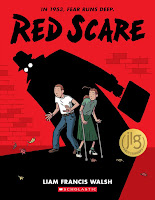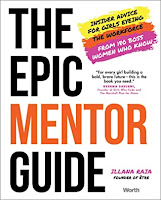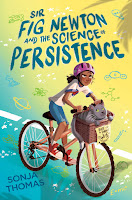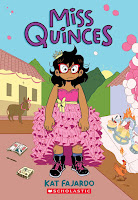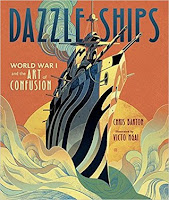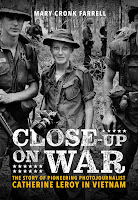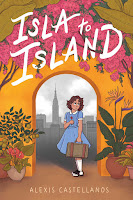Farid, Diana and Goto, Kris (illustrations).
Wave March 29th 2022 by Cameron Kids
ARC provided by Young Adult Books Central and Blue Slip Media
Ava lives in Southern California in the 1980s, and loves to surf and to sing along with pop hits of the day. She's been friends with Phoenix forever, and has recently realized she has a crush on him. Her Iranian born mother is an OB/GYN and is very excited about her job, which takes a lot of her time. Ava's father has never been present in her life, and only occasionally reaches out with late birthday gifts or superficial phone calls. Because her mother works and has been divorced, the Persian community frowns on her a bit, and Ava's fashion sense sets her apart as a young woman who might not be the best candidate for marriage. Ava's mother wants her to consider a career in medicine, so when summer arrives, arranges for her to work at the hospital as a junior volunteer (sort of like a
Candy Striper, for those of us who are older!). Ava would much rather hang out at the beach with Phoenix to surf, or with her best friend Naz, who is also Persian. It's not a horrible job, and she does enjoy connecting with some of the patients, but when she falls and breaks her leg on the job, she is even angrier with her mother. Phoenix, whose father also works at the hospital and who lives next door, has battled cancer in the past, but when it reemerges, his prognosis is not good. Ava is sure that, with her help, he can overcome the disease again. She tries to encourage Phoenix to continue with his music and surfing, but as his condition worsens, he has less and less energy. This sends Ava into a panic, but also makes the two realize the depth of their feelings for each other.
Wave captures the feeling of 1980s beach culture with a story in verse strongly reminiscent of Lurlene McDaniel's tear-jerkers like Six Months to Live (1985). Whereas the McDaniel books were a bit more mellowdramatic and definitely more white, Wave is a great mix of Persian culture, 1980s music references, and Ava's own issues mixed in with Phoenix's medical problems. I loved that not only was there a description of how to make a mix tape from songs on the radio, but there was a list of songs at the end of the book. Young readers will be completely amazed.
Ava has a lot going on, and her struggles with balancing all of the expectations her mother has of her are vividly depicted. She's conflicted about her father, dealing with rampant racial microaggressions, and finding it hard to process her feelings about Phoenix. I found it particularly interesting that she found it easier to pass as Latinx, but this makes sense. The Iranian hostage crisis would have been fresh in the minds of people at this point in history, and this fact is addressed.
Goto's page decorations add a fun element to the story, and look a bit like designs from adult coloring books, with their fine details. This will definitely appeal to young readers, but part of me wanted them to have a 1980s/Max Headroom/rebooted Art Deco look from that time period.
There aren't a lot of books about Southern California beach culture, and that's too bad. From my midwestern viewpoint, this is an interesting and exotic setting! Forman's
Frankie and Bug is the newest book that explores this setting fully. There are also very few books about surfing. Guidroz's
Samira Surfs , Colbert's
The Only Black Girls in Town, and Mosier's
Summer and July being the only recent entries with that representation. This makes Wave an intriguing mix of a lot of interesting factors, with the added element of Ava and Phoenix's star crossed romance.
I was a bit surprised that the print was SO tiny. There's a lot of concrete poetry, so I guess the small size was necessary to fit everything on each page, but it may dissuade some picky middle grade readers.
Feinstein, John.
Mixed Doubles: A Benchwarmers Novel (The Benchwarmers #3) March 8th 2022 by Farrar, Straus and Giroux (BYR)
E ARC provided by Edelweiss Plus
Andi and her friend Jeff are back in the spring after soccer season (
Benchwarmers, 2019) and basketball season (
Game Changers, 2020). Tennis is a new sport in their middle school, and the teams are co-ed, with one male and one female coach. It turns out that Andi is an evern better tennis player than she is a soccer or basketball player, which is saying a lot. Jeff is okay, and glad that he can occasionally partner with her in mixed doubles. When Andi's playing brings the attention of agents who are interested in signing her parents, things veer into the realm of investigative journalism. Jeff's father, a sports reporter, thinks it is odd that agents (no matter what they call themselves) are targeting an eleven year old girl, but as more agents approach her, and as other players mention having been approached, the two know there is a story. At the same time, Jeff is demoted to the number two spot on the team, and Gary gets to partner with Andi. It turns out that the one coach, a former tennis player herself, is working provisionally for one of the agents, and puts Gary in to make his father happy and put her in a better position to get hired as a full time agent instead of working as a teacher. Feeling that there is a lot of research that needs to be put into the story, Jeff reaches out to Stevie, a college reporter, and his friend Susan Carol, who was a swimmer in 2012's
Go For the Gold. They recommend getting lots of documentation, so Andi (with her parents' permission) meets with three of them to get provisional contracts. Once those are in hand, Jeff's father arranges to have cameras at the championship match so that the agents' tactics can be revealed.
Strengths: There are not very many tennis books out there, and it's a sport that some middle school students play, if not at school, through a club.
Having watched Andi in the other books, it's fun to see that tennis is where she really excels! Jeff's crush on her, and her pragmatic view that she's only eleven and too interested in sports to be interested in boys, strikes a good note. The parents show up only when important, and the use of investigative journalism to uncover an unhealthy fascination with very young sports players is not a topic much covered, although it is a favorite of Feinstein's. (2018's
The Prodigy is an exceptionally good example.) I apparently don't understand tennis at all, but there are a lot of details about the game, and other competitors and their styles of play, as well as their parents' insistence on getting an agent! This was a solid continuation of an interesting series.
Weaknesses: Jeff and Andi ate a distractingly large amount of pizza. Seriously. In almost every chapter, it seemed. And when they weren't eating pizza, they were going out to eat steak with their parents.
What I really think: Definitely purchasing, since I enjoyed watching Andi play soccer and basketball. Not quite sure if this is the end of the series, or if the two will pick up baseball over the summer to round off the series!





